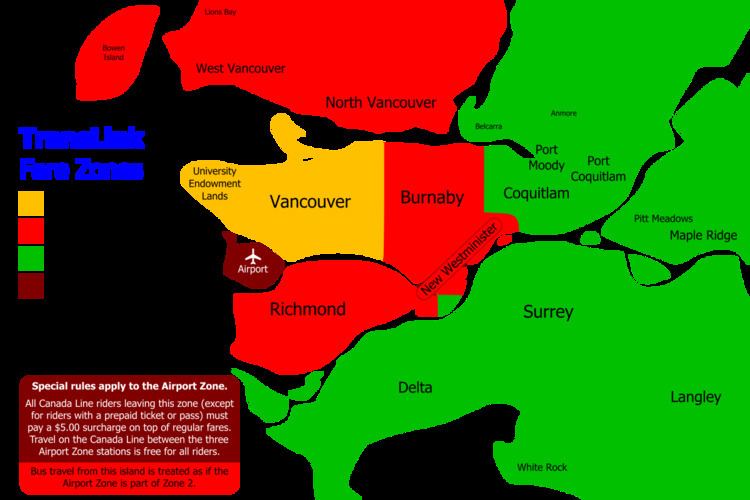 | ||
U-Pass BC is a student public transportation monthly pass valid through British Columbia and on the TransLink system in Metro Vancouver.
Contents
The original concept of a regional-wide initiative was expanded province-wide in June 2010, when the provincial government created the U-Pass BC program that offers standardized transit program for all public post-secondary students effective September 2010.
The Lower Mainland program is currently available to students attending the University of British Columbia, Simon Fraser University, Capilano University, Langara College, Emily Carr University of Art and Design, Vancouver Community College, Douglas College, Kwantlen Polytechnic University, British Columbia Institute of Technology, and Nicola Valley Institute of Technology. The Justice Institute of British Columbia has opted not to participate in the program.
Pass holders are eligible to use HandyDART if requirements are met and also for discounted fare on the West Coast Express.
On June 1, 2015, the U-Pass BC paper fare passes were phased out in favor of the Compass Card for students at BCIT, Langara, SFU and UBC. The U-Pass fully converted on July 1, when students at Capilano and VCC switched over.
History
The Metro Vancouver region U-Pass program was first implemented in September 2003 by TransLink with the sponsorship of Vancity. It was first implemented at UBC and SFU but was further expanded to Capilano University and Langara College in 2009.
On June 9 2010, the Province announced that U-Pass program would be expanded into a province-wide initiative at a rate of $30 per month. At the same time, it was announced that Vancity would no longer be a sponsor for the program.
On September 1, 2011, the U-Pass BC program officially launched at 11 public post-secondary institutions. Under the new program, monthly bus passes were issued to each student using custom built dispensers, designed for the purpose. The Dispenser Solution, used at all the lower mainland post secondary institutions with the exception of Emily Carr University, was designed, developed and implemented by Kyle Fairfield, VP Sales for E-CARD ID Products Ltd. It issues an estimated 40,000 to 50,000 U-Passes per month at all institutions.
Fee
The fee for the U-Pass is currently $39.50 per month for all students. The U-Pass allows unlimited travel in all zones on buses, SkyTrains and the SeaBus. This represents a significant savings over the current $170 fee for the equivalent three-zone monthly pass, or a one-zone pass with a FastTrax sticker previously required.
On April 1, 2013, the U-Pass monthly fee increased to $35 per month. Fees are paid with tuition and student fees, and all students (regardless of whether they take on-campus or distant education courses, or even on a co-op term) must purchase the pass, though in some circumstances, students may opt out.
U-Passes are non-transferrable and (before the Compass Card) students were required to have their name printed on the back of their paper pass. Fraudulent use may result in criminal charges or a fine. Students are required to carry supplemental identification (student card) and produce it for inspection, along with the U-Pass, upon request of a Transit Security Officer or a member of the South Coast British Columbia Transportation Authority Police Service. Failure to produce supplemental identification (student card) upon request may result in confiscation of the U-Pass, a fine for not having a valid fare in a Fare Paid Zone, and/or restriction from receiving a U-Pass for an indefinite period.
Popularity
According to the UBC U-Pass site, since the UBC U-Pass was implemented, transit ridership now accounts for 42% of all trips to UBC, a figure expected to grow by ten percent per year. In a referendum at UBC, the students voted 92% in favour of continuing the program. According to the U-Pass Final Review, Transit ridership at UBC has increased by 63% since the implementation of the U-Pass, 37% of UBC students reported that they have been able to avoid buying a car as a result of the U-Pass and 69% have been able to reduce their reliance on a car due to the pass.
According to the SFU U-Pass site, in a referendum held at SFU in March 2005, students voted 83% in favour of continuing the U-Pass program until at least September 2008, and 88% of SFU students currently use a U-Pass. Transit ridership to SFU's Burnaby Campus has increased 48% since the launch of the U-Pass program. In addition, one third of SFU students reported that they avoided the need to purchase a vehicle and over 60% reported a reduced reliance on automobiles since the introduction of the Pass.
Environmental benefits
According to the U-Pass Review Final Report, Translink has estimated that by May 2005, regional green house gas emissions had been reduced by 3,000 tonnes as a result of the SFU U-Pass program and 8,000 tonnes as a result of the UBC U-Pass program.
